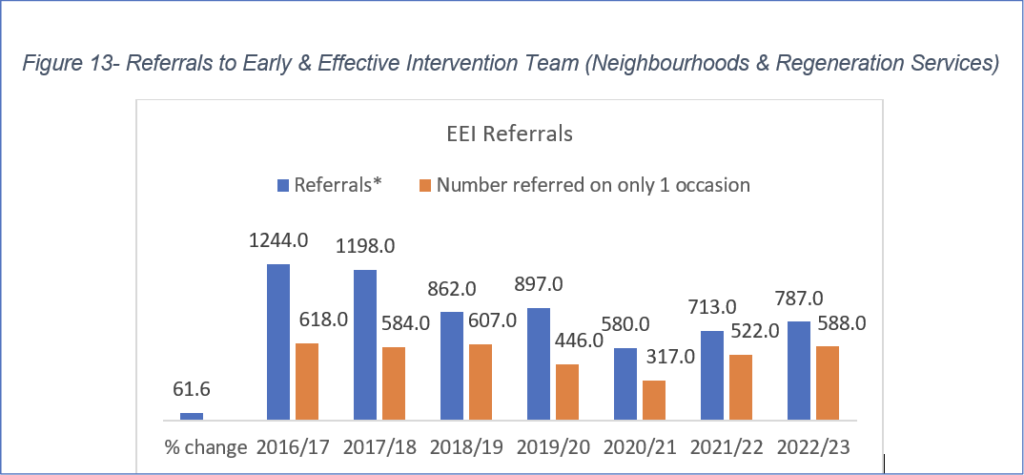NATIONAL AND LOCAL PERFORMANCE HIGHLIGHTS
Policy, Planning & Development Officer, Community Justice Glasgow
A revised National Strategy for Community Justice was published in June 2022 with the accompanying Delivery Plan published in June 23.
A revised Community Justice Performance Framework to support the revised Strategy was published in March 2023, setting out:
- 9 nationally determined outcomes which are to be achieved in each local authority.
- 10 national indicators which are to be used to measure performance in achieving the outcomes.
With the new National Community Justice Performance Framework now available and accompanying Guidance and Technical Note, over 2022/23 the Community Justice Glasgow Partnership will develop and agree a new suite of local evidence, which will supplement the national indicator data, providing further context to enable local analysis to be undertaken to explore specific improvements that may be needed.
The highlight data provided below is drawn from the legacy Performance Framework indicators and local data that was available at the time of reporting. Several key data sets that we would normally have reported on are not available at this time, or there are gaps in the data, whilst new nationally provided data is in development.
Going forward we will be reporting on the new national indicators and local Community Justice Glasgow Performance Framework.
You will also see lots of data in the context of its delivery sprinkled across the many articles that are contained within this Annual Reporter.
One Year Reconviction Rates
Context and Analysis – The one-year rate is taken as the percentage of offenders, for a given offender cohort, reconvicted within one year of commencing a community-based sentence or being released from prison. A downward trend in this data would indicate that less offenders are being reconvicted (reduced reoffending). The 2018/19 cohort is the last publication from Scottish Government in this format and this data will no longer be supported for the new National Performance Framework.
There is a 2-year lag in this reporting meaning that the data shown for 2021 (2018/19 cohort) will not reflect performance over 2022-23. You will however see that in the most recently published data (Figure 1 Below), the reconviction rates for those from Glasgow was showing progress and sitting closer to or less than the Scotland-wide figures.
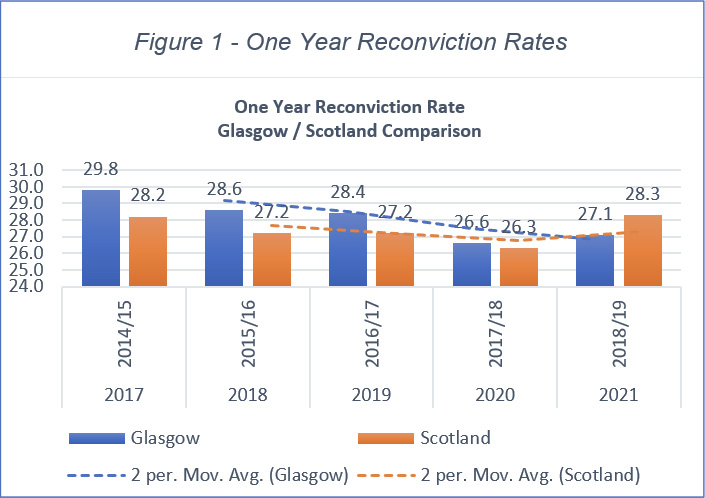
Recorded Crime
Context and Analysis – Statistics on recorded crimes and offences provide a measure of the volume of criminal activity with which the police are faced. This does not reveal the incidence of all crime committed as not all crimes are reported to the police. It should be noted that the Coronavirus (COVID-19) pandemic, and associated measures to limit social contact, has had an impact on both the type and volume of crime recorded since March 2020. A larger impact was seen during 2020-21, and to a lesser extent 2021- 22. The final legal restrictions were lifted in April 2022, suggesting a much more limited impact in 2022-23.
Figure 2 below shows a mixed picture with overall recorded crime between 2021-22 and 2022-23 up by 2.6% – as discussed in the paragraph above, this can in part be explained by the impact of the Pandemic’s restriction measures creating a lower starting point in 2021-22. When measuring 2022-23 rates against 2019-20 (pre-Pandemic) there is a much more positive picture with reductions across most crime types. We are aware of the spike in sexual offending and looking at this as an improvement area within the Partnership.
Community Justice’s overarching measure is to reduce reoffending. Recorded crime does not directly indicate reductions in reoffending. Direct attribution is not possible; however, it does give a good indication of whether the Community Justice Glasgow Partnership’s interventions and initiatives are having an impact locally (recognising that there will also be many other factors at play). Going back to Figure 1 (discussion around reconviction) consistently 25 – 30% of crime is committed by someone who is reoffending within 1 year of a previous sentence and a connection can be made between a reduction in recorded crime rates and reductions in reoffending.

Crime Victimisation Rates
Context and Analysis – Crime victimisation rates measure the incidence of personal and household crimes – as perceived by victims of crime themselves, rather than Police records of reported crimes. This may provide a better measure of the actual incidence of crime in our communities.
A high victimisation rate suggests an unsafe community, which impacts on people’s quality of life and may deter public and private improvements or investment.
The crime victimisation rate comes from the Scottish Crime and Justice Survey, a Scottish Government household survey of 16,000 households across Scotland. Data was available annually from 2006/07 to 2010/11 and once every 2 years from then on. Data beyond 2020 was not yet published at time of writing.
You will see from the tables below, Figures 3 and 4, that there was good progress in Glasgow over the last reported period – showing a 2.2% reduction in overall crime victimisation rates and a 1.4% decrease in violent crime victimisation rates from the previous reported period. Again, there is a significant lag in this data which may not reflect the 2022-2023 situation directly but does show some positive progress in recent years.


Community Payback Orders
Context and Analysis – Community Payback Orders with Unpaid Work are one of the key levers in reducing the risk that a person will re-offend. They provide better opportunities (when compared to a short-term prison sentence) to address the underlying drivers of an individual’s offending behaviour such as poor mental health, drug and/or alcohol misuse, adverse childhood experiences and/or trauma.
At time of publication, 2022-23 figures were not available. You can see from Figures 5 below that Orders commenced in Glasgow took a fairly steep dip over 2020/21 (1,286) and 2021/22 (1,652) when compared to the previous period 2019/20 where orders commenced stood at 2,536 (closer to the trend average). This was due (at least in part) to the restrictions imposed during the Covid19 Pandemic and subsequent Court backlogs and inability to deliver Community Sentences safely. However, as shown in Figure 6, where orders were commenced, the successful completion rates for both those periods showed increases from pre-pandemic levels. Encouragingly, breach rates, as a % of orders commenced Figure 7, also shows a corresponding downward trend.
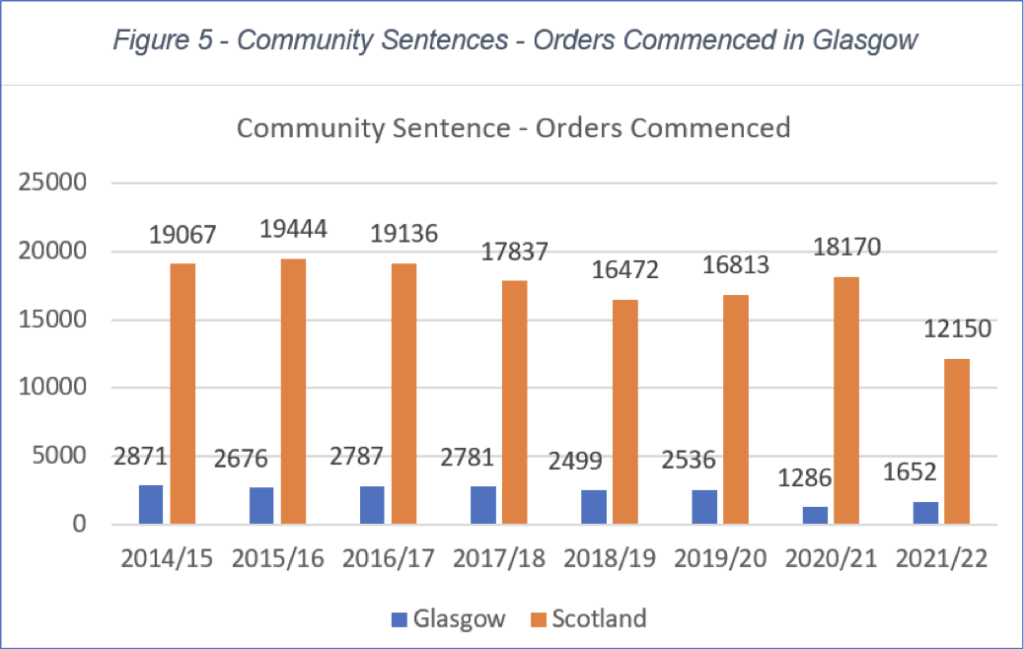
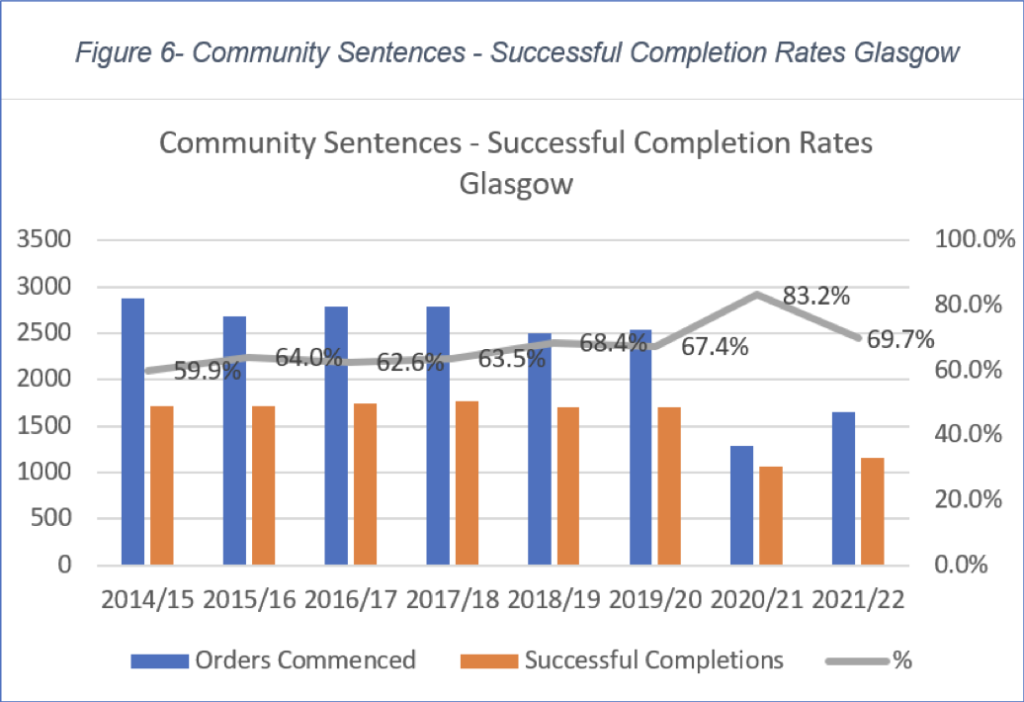

Community Justice advocates for Community Sentences as a robust alternative to the short-term prison sentences that this lower level/tariff offending would otherwise attract. They have the added advantage of a reparative element which benefits communities in the form of unpaid work projects carried out that would not otherwise have been completed with paid employment. Figures 8 and 9 below show an encouraging trend of increased numbers of hours where reparation was made to the community in the form of Unpaid Work carried out as part of Community Payback Orders.

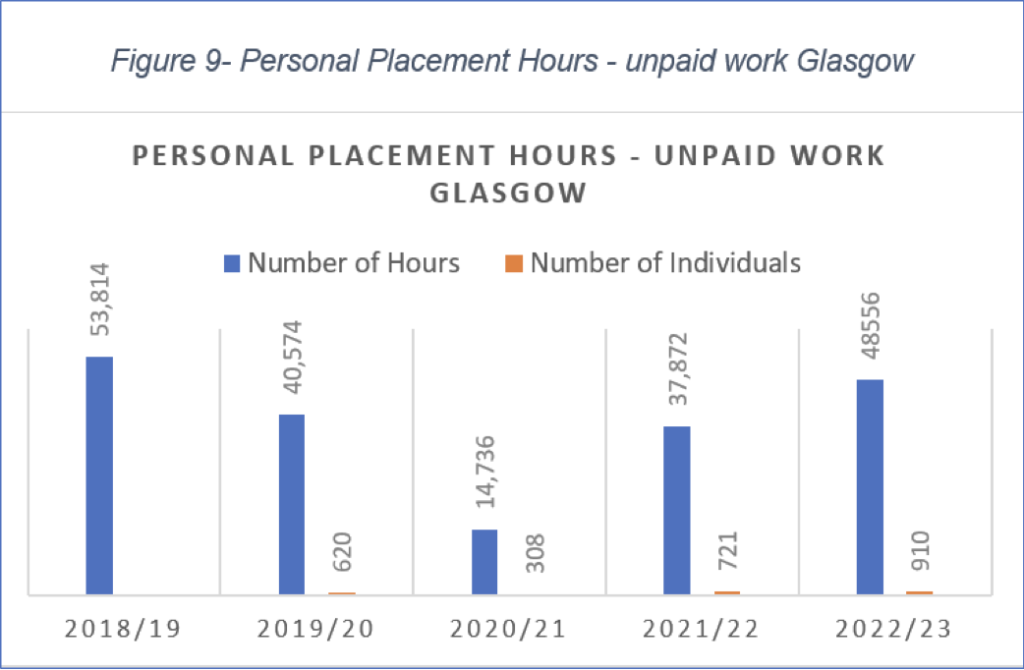
Diversion from Prosecution
Context and Analysis – Diversion from Prosecution, as an earlier intervention, is another key lever in reducing the likeliness that an individual will re-offend. It allows the individual to work with a service(s) to undertake a programme of activity to address their offending behaviour. If successfully completed, the Crown Office & Procurator Fiscal Service can take the decision not to prosecute. This has the added advantage of not putting in place further barriers that could prevent the individual moving on to a more positive pro-social destination.
Community Justice partners work together to ensure that there is a robust range of services available to address different underlying drivers of offending behaviour and to give the Procurator Fiscal Service confidence to divert a range of offences and needs to improving the processes and information flow between key partners to ensure that the opportunity is maximised.
Figures 10 and 11 below suggest that this proactive partnership approach is paying off with an upward trend in both referral numbers (suggesting confidence from Procurator Fiscal Service) and successful completion rates – suggesting that individuals are being referred to the right service to address their behaviours.


Homelessness Leaving Prison
Context and Analysis – For the Community Justice perspective, improving housing outcomes and reducing the incidences of people leaving prison without suitable accommodation is a key lever in reducing the risk that an individual will re-offend. Often having suitable accommodation is the starting point for stability and for engagement with a wide range of supports, that can be wrapped around a person, to meet their often complex, needs.
Community Justice Glasgow partners have worked through the Prison Housing, Health & Benefits (PHHaB) initiative to improve the information and appropriate data flow, working with Registered Social Landlords to reduce the number of individuals leaving prison without suitable accommodation and/or securing their existing tenancy where appropriate.
At the end of its second year 2022/23 the project reported:
- 100% of referrals secured accommodation on departure, with 81% provided at least one additional support service;
- a growth from 20% of prison leavers provided accommodation with a Registered Social Landlord in 2020/21 to 74% in 2022/23; and
- a reduction from 40% of prison leavers placed in Bed & Breakfast to 11% in the same period).
The reducing trend in homeless applications Figure 12 from prison leavers suggests that this work is starting to pay off.

Early & Effective Interventions
Context and Analysis – The use of targeted and tailored early intervention is a key aspect of reducing the risk that young people will re-offend. This part of a whole systems approach, identifying young people at risk of, or already involved in offending, and tailoring interventions to their needs. Evidence tells us that this is the right thing to do and achieves better personal outcomes for the individuals as well as reducing the risk that they will reoffend or escalate the severity of their offending to the benefit of communities and the system as a whole.
Taking the information simultaneously from Figures 13, 14 & 15 below, we can summarise the impact for 2022-23:
- The number of referrals to Early & Effective Interventions Team (EEI) increased by 10.4% (a total change of 74 referrals), this measure could suggest that more young people coming to the attention of the Police on offence related grounds (increased volume of offending). Note though that it is still significantly less than the pre-pandemic period (over which there was a significant drop in a 2-year period). When comparing to 2019/20 (pre-pandemic) there were 110 less referrals -12.3%.
- The number referred only once increased by 12.6% (66 individuals) – at a higher rate than overall referrals (10.4%) suggesting an increased success rate with initial interventions.
- Referrals on to Neighbourhoods & Regeneration Service Intervention Team (more serious cases are referred to this team) increased by 3.1%, a lower rate than the increase in overall referrals (10.4%) – this could suggest a decrease in the seriousness of the offences being referred. This is in-consistent with an increase in the number of young people (10.1%) and increase in the volume of offending (referrals) reported to SCRA on offence related grounds (27.8%) which suggests an increase in gravity and frequency of offending. This requires more analysis.
- The % of those referred to the Early & Effective Intervention Team who fully engaged with the programme increased by 46.4% and the successful completion rate rose by 41.9% – suggesting appropriate targeting of resources.
